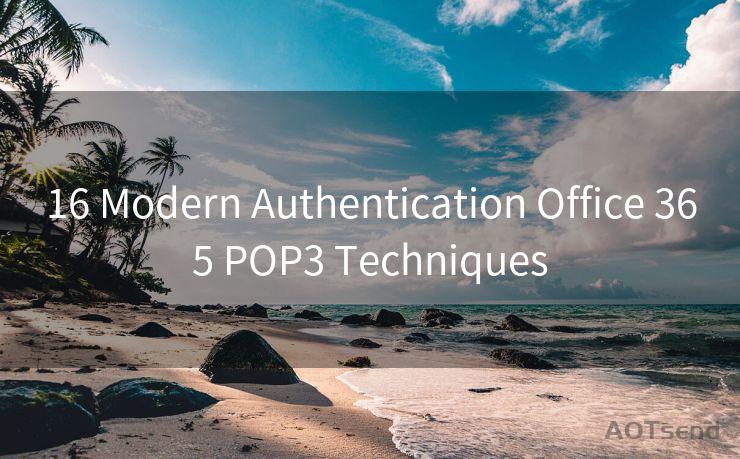16 Modern Authentication Office 365 POP3 Techniques




Introduction
In the ever-evolving landscape of email communication, Office 365 and POP3 (Post Office Protocol 3) remain staples for businesses and individuals alike. With the advent of modern authentication techniques, securing these email protocols has become paramount. In this blog, we explore the top 16 modern authentication techniques that enhance the security of Office 365 and POP3.
1. Multi-Factor Authentication (MFA)
Multi-Factor Authentication adds an extra layer of security by requiring two or more verification methods, such as a password and a fingerprint or a one-time password sent to a registered mobile device.
2. OAuth 2.0
OAuth 2.0 is an open standard for authorization, allowing third-party applications to access user account information without using the user's password. This ensures that sensitive credentials are not exposed.
3. Conditional Access Policies
Conditional Access Policies in Office 365 allow administrators to set rules that determine who and what devices can access email accounts. This adds a robust layer of protection against unauthorized access.
4. Secure Socket Layer (SSL)/Transport Layer Security (TLS)
Using SSL/TLS ensures that data transmitted between a client and server is encrypted, preventing eavesdropping or tampering.
5. Advanced Threat Protection (ATP)
Office 365's Advanced Threat Protection offers features like safe links and safe attachments, which protect users from malicious content.
6. Azure Active Directory Identity Protection
Azure AD Identity Protection leverages cloud-based risk detections to identify potential vulnerabilities and protect against compromised identities.
7. Passwordless Authentication
Techniques like Windows Hello and FIDO2 security keys allow users to authenticate without passwords, reducing the risk of credential theft.
8. Risk-Based Conditional Access
This feature evaluates the risk level of each sign-in attempt and applies additional security measures if necessary.
9. Smart Lockout
Smart Lockout in Office 365 can detect and block brute-force password attacks, protecting user accounts from being compromised.
10. Privileged Identity Management (PIM)
PIM provides just-in-time administrative access to reduce the exposure of privileged accounts to potential threats.
11. IP Address Restrictions
Restricting access to specific IP addresses or ranges can further limit unauthorized access attempts.
12. Device-Based Conditional Access
This allows administrators to control access based on device compliance, such as ensuring devices are not rooted or jailbroken.

13. App-Based Conditional Access
Administrators can restrict access to Office 365 data based on the approved applications being used.
🔔🔔🔔
【AOTsend Email API】:AOTsend is a Managed Email Service for sending transactional emails. Support Email Types: reminders, authentication, confirmations, notifications, verification codes, invoices, password resets, account activations, billing statements, two-factor authentication (2FA), and one-time passwords (OTP) emails, etc. $0.28 per 1000 Emails. 99% Delivery, 98% Inbox Rate.
You might be interested in:
Why did we start the AOTsend project, Brand Story?
What is a Managed Email API, How it Works?
Best 25+ Email Marketing Platforms (Authority,Keywords&Traffic Comparison)
Best 24+ Email Marketing Service (Price, Pros&Cons Comparison)
Email APIs vs SMTP: How they Works, Any Difference?
14. Location-Based Conditional Access
This feature restricts access to Office 365 based on the user's geographical location.
15. Sign-In Risk Policy
Allows administrators to define policies based on the risk level of sign-in attempts, blocking high-risk attempts.
16. User Risk Policy
Similar to Sign-In Risk Policy, but focused on user behavior patterns to identify and mitigate potential risks.
Conclusion
In conclusion, these 16 modern authentication techniques for Office 365 and POP3 provide comprehensive security measures to ensure data safety and protect against unauthorized access. Implementing these techniques can significantly enhance the security posture of any organization relying on email communication. As the threat landscape continues to evolve, it's crucial to stay vigilant and proactive in securing our digital assets.




Scan the QR code to access on your mobile device.
Copyright notice: This article is published by AotSend. Reproduction requires attribution.
Article Link:https://www.mailwot.com/p3049.html



